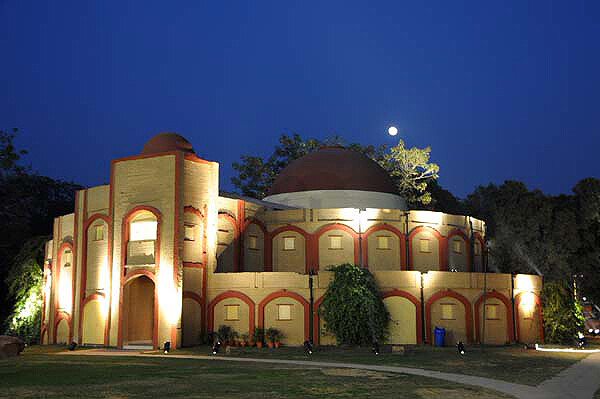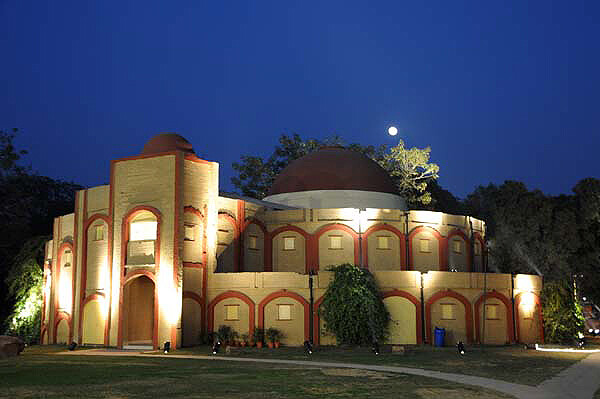A dilapidated building earmarked for demolition and destined to join the debris of socialist modernity in Jia Zhangke’s 2006 film Still Life abruptly transforms into a UFO in the middle of the night and takes off to an uncertain future. A moment of flight that rejects the burden of the real and the preordination of history serves equally well as a guide to the curatorial imagination of “INSERT2014,” an exhibition presented by the Inlaks Shivdasani Foundation and curated by the Raqs Media Collective. However, unlike utopian flights, which are assured of a successful take off, if not a landing, “INSERT2014” plays with the idea of a suspended moment between stasis and movement, the animate and inanimate, and potential and failed promises as a way of thinking about the contemporary global moment and Delhi’s place in it. Taking place in the shadow of the India Art fair—an annual event that has come to be associated with the burgeoning Indian art market and is, sadly, more known for its engagement with sky-rocketing art prices than with ideas—“INSERT2014” literally inserts itself as an interruption of the seamless integration of the art world into Delhi’s twenty-first century.
The Mati Ghar, which hosted the exhibition, is a peripheral gallery space run by its parent bureaucratic cultural institution, the Indira Gandhi National Centre for the Arts (IGNCA), whose name—so we learn from the accompanying exhibition catalog—alludes to the maati-ghar, or temporary mud housing annexes typically found in rural Indian villages.1 Its strange architecture, which contrasts with the modernist aesthetics of the IGNCA, thus lies somewhere between tradition and modernity. The Raqs Media Collective describes the building as something that “could be a stupa, if it were not an UFO, transfixed in the indecision between lifting off into space and burrowing into the earth’s core,” and is transformed into a playful space station in which a number of works literally hover like the dwarf in Friedrich Nietzsche’s 1883–85 Thus Spoke Zarathustra between two realms—the past and the future—to meet at a gateway called the “moment.”2
Kendell Geers’s Hanging Piece (1993), for instance, could be seen either as bloody red bricks hanging heavily from the ceiling by a hangman’s noose or they could be bricks defying gravity as they strive to ascend to the stars (or possibly, participating artist Ivana Franke’s stratosphere) on a fragile rope. Walking under these bricks, the spectator’s physical and moral well-being is better assured by the second of these interpretations. In his own reflection on the work, Geers invokes the metaphor of quantum physics, arguing, “the single electron, proton or quark is not unlike a work of art.”3 He continues, “In themselves and alone, they are seemingly inconsequential and insignificant, but in context they perform like the ripples that are caused by the fall of a brick as it drops into the pool of our imagination.”4
The reference to physics is indeed a fruitful way of navigating the show, as well as the ways in which the works resonate with one another, because its curatorial design relies less on intertextual references and more on creating resonances. If in physics, resonance could be defined as the “tendency of a system to oscillate with greater amplitude at some frequencies than at others,” what the exhibition achieves is an amplification and intensification of our sense of the present through the creation of a resonant frequency across all of the works.5 Thus, one might understand the fragile density of Geers’s bricks as reverberating with a different pulse in Tomás Saraceno’s delicate social… quasi social… solitary… spiders on hybrid cosmic webs (2014).
Saraceno, whose body of work treats the gallery space as a biosphere, has in turn speculated elsewhere about the possibility of launching cities into the sky. It is perhaps appropriate that he collaborates with a spider to create a web suspended in a mesh that allows you to see the interconnectedness of the world, which renders the traditional lines separating nature from culture, or art from life, vacuous. And if the spider is itself missing from the web, it might be because it has mutated into a woman across the corridor, voluntarily suspended from a rope dreaming of Spiderman, bondage, and freedom in Hito Steyerl’s 2007 film Lovely Andrea. Or perhaps it rests within Contest of Illusionists (2013/14), Clark House Initiative collaborator Amol K. Patil’s bed of bricks, satisfied with the universe it has created?
Whether one thinks of these crisscrossing energies in “INSERT2014” as lines of flight, or as an aesthetic force field that creates new patterns of seeing the world, there is no doubt that the members of Raqs see themselves less as curators and more as archeological adventurers, skillfully excavating our uncertain future. With the help of other artists, they aim to produce a denser sense of the present—one in which, even as the accumulation of capital and information seems to define our preordination in time, the accumulation of being ensures our freedom from it. In his reflections in the exhibition catalog, on the making of “good contemporary art,” Lu Xing-Hua retraces French philosopher Alain Badiou’s path, in which it is the quantum dynamics of politics, science, art, and love that allows the contemporary subject to claim their own destiny.6 Comparing contemporary art with these other domains, Xing-Hua claims that art done well “is equivalent to, in politics, a revolution; in science, a jolt to the status quo akin to the theory of relativity or quantum mechanics; in love, the liberation of a desire.”7 He expands on this premise by noting, “A contemporary art action should resemble an act of love, a scientific experiment, or a political project. It is an adventure. Indeed, a good contemporary art action must be the newest and deepest of adventures.”8
I read this assertion as a form of sovereign claim—one in which art continues to provide seditious resources for the contemporary, and the individual art works in “INSERT2014” contribute both singularly and collectively to Raqs’ declaration of independence, singing in the “whisper of sedition and heresy,” by refusing the blackmail of the imminent.9 And the work which perfectly brings together the exhibition’s thematic and affective concerns is Franke’s In the Faraway Past and in the Future (2014). Crafting an intricate galaxy on the dome of the Mati Ghar, and made entirely from something as simple as fishing lines, Franke produces a galaxy that moves and dances to the rhythm of the spectator’s careful steps as they walk looking upwards, aware that no one else is seeing what they are seeing, but also not unduly distressed by this fact. Is it the Kantian sublime that we feel as we gaze up at this fishlined galaxy? Perhaps, but unlike Kant’s starry heaven, which depends on its absolute distance to produce a sense of wonderment, Franke’s sublimity seems tantalizingly within our reach. All we need to do is take a few small steps and insert ourselves in the midst of a new adventure.
For more information on the project, see: http://www.insert2014.in/. For a conceptual discussion of the Mati Ghar, see: Clark House Initiative, “Of Spaceships, Second Citizens, and Things Made in Mud,” in INSERT2014, ed. Shveta Sarda (Mumbai: Inlaks Shivdasani Foundation, 2014), 26–32.
Raqs Media Collective, “INSERT: Draft for an Operating Manual, Score for Choreography, Plan for an Exhibition,” in INSERT2014, 3.
Kendell Geers, “Thoughts on Hanging Piece,” in INSERT2014, 40.
Ibid.
Lu Xing-Hua, “What Makes a “Good” Act of Contemporary Art?” in INSERT2014, 58–59.
Ibid, 59.
Ibid.
Raqs Media Collective, 4.








